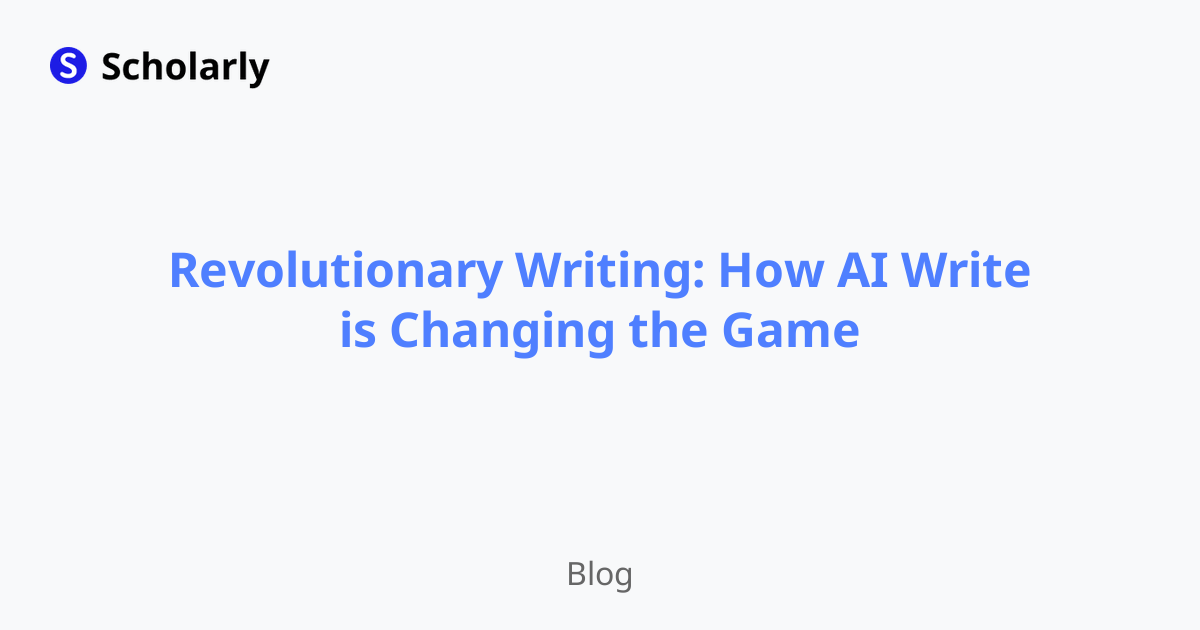Revolutionary Writing: How AI Write is Changing the Game
Discover how AI is transforming the way we write with 'Revolutionary Writing: How AI Write is Changing the Game'. In this in-depth article, learn about the past, present, and future of AI in writing, explore the benefits, significance, best practices, pros and cons, and the potential applications through powerful online apps like Scholarly. Dive into an SEO-optimized guide that combines history, comparisons, methods, and common techniques, showing how artificial intelligence is reshaping the landscape of writing and content creation.

Revolutionary Writing: How AI Write is Changing the Game
As we stand on the precipice of a new era in content creation, it is crucial to recognize the seismic shifts occurring within the realm of writing. This comprehensive SEO-optimized article delves into the monumental influence of artificial intelligence on writing, dissecting the past, present, and anticipated future developments. It highlights the advantages and nuances, offers best practices, evaluates the pros and cons, and scrutinizes various tools and methods used in AI writing. The article emphasizes the digital revolution's cornerstone, AI, and examines its applications, from techniques and challenges to its integration within online apps such as Scholarly, which is pioneering the advancement of AI-assisted learning.
Introduction
The age of artificial intelligence is upon us, with its tendrils extending into every aspect of our daily lives, including the art and science of writing. This article outlines the evolutionary journey of AI in writing, dissecting how it affects our interaction with text, from conception to completion. It will navigate through the History of writing tools, the current and future state of AI in writing, and the Benefits it brings. We delve into the Significance of AI writing, outline Best Practices for maximum efficiency, weigh the Pros and Cons, conduct a Comparison of current tools, and unpack various Methods and Common Techniques. Essential challenges will be addressed, followed by a look at Potential Online Apps that relate to the topic, before culminating in a summarizing Conclusion.
We begin by stepping back in time to evaluate older writing processes and move forward to examine the role AI currently plays in transforming these practices. We speculate on future advancements, understanding that the tools we have now, like Scholarly, are just the beginning of what will become a deeply integrated system of writing assistance.
The Historical State of writing saw the utilization of typewriters and word processors, which were once considered revolutionary. The transition to digital word processing was a major leap, but the Current State has been dramatically altered by the advent of AI writing tools that offer unprecedented assistance and versatility. Looking ahead to the Future State, we anticipate even more sophisticated AI applications that will further disrupt traditional writing methodologies, potentially automating not only the generation of content but also its curation and distribution.
In discussing Benefits, it's vital to pinpoint the tangible improvements AI brings to the writing process, from enhanced efficiency to a higher quality of the final product. With AI, repetitive tasks can be automated, the speed at which content is produced increases, and the scope for personalization and accuracy broadens.
The Significance of AI in writing cannot be overstated. It's a tool that empowers, enhances, and streamlines the craft of writing. Whether it's for educational purposes, professional communication, or creative expression, AI writing tools have carved an indelible niche in the landscape of written content.
Adhering to Best Practices when integrating AI into writing ranges from establishing a clear objective to maintaining a human touch within the AI-generated content. Understanding the capabilities and limitations of AI writing tools enables a harmonious blend of human creativity and machine efficiency.
The Pros and Cons section offers a balanced analysis, presenting the advantages such as time savings and consistency alongside potential drawbacks like the loss of unique authorial voice or over-reliance on technology.
Our Comparison evaluates various AI writing tools, detailing their features, strengths, and weaknesses. Scholarly, for instance, offers a seamless experience of AI-generated text completion, flashcard creation, and an AI-powered tutor, championing the cause of efficient learning.
Methods encompass a range of AI writing techniques, from simple auto-correction to full-scale content generation. We inspect different strategies employed by various applications to complement the writing process.
An exploration of the Common Techniques used in AI writing reveals the ever-growing toolbox at the disposal of writers, encompassing everything from keyword optimization to narrative structuring, while Challenges acknowledge the ethical and practical hurdles that lie ahead.
We also investigate Potential Online Apps, such as Scholarly, which are revolutionizing how we engage with text-based content. Applications that support AI-driven learning, transcription, and content conversion are reshaping the educational landscape.
Finally, the Conclusion draws links between all the topics covered, summarizing the significant stride AI has made in the world of writing. Each subheading in this conclusion echoes the depth and breadth of the impact AI write has had and will continue to have in the game of writing.
Try Our Popular AI Study Tools
Transform your study materials into interactive learning experiences with our most popular AI-powered tools:
PDF to Flashcards
Convert lecture notes and textbooks into study flashcards instantly
Text to Flashcards
Turn any text or notes into comprehensive flashcard sets
Image to Flashcards
Convert diagrams and handwritten notes into digital flashcards
YouTube to Flashcards
Generate flashcards from educational video content



